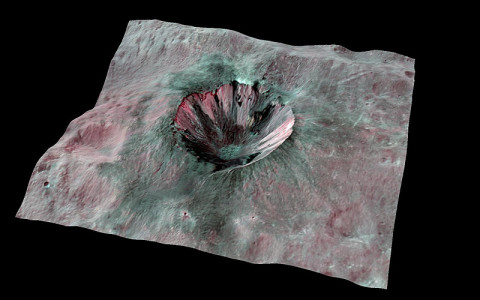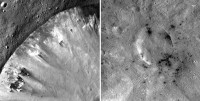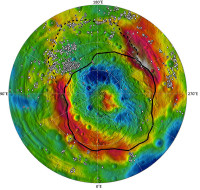Written by Jia-Rui C. Cook
NASA’s Jet Propulsion Laboratory
 Pasadena, CA – A new study of images from NASA’s Dawn mission examines remarkable, dark-as-coal material that speckles the surface of the giant asteroid Vesta. Scientists are using the images, taken by Dawn’s framing camera, to understand the impact environment early in Vesta’s evolution.
Pasadena, CA – A new study of images from NASA’s Dawn mission examines remarkable, dark-as-coal material that speckles the surface of the giant asteroid Vesta. Scientists are using the images, taken by Dawn’s framing camera, to understand the impact environment early in Vesta’s evolution.
In the most comprehensive analysis of the dark material to date, Dawn scientists describe how this carbon-rich material tends to appear around the edges of two giant impact basins in Vesta’s southern hemisphere.

Some of those materials were later covered up by the impact that created the younger basin, Rheasilvia.
The paper, published in the November-December issue of the journal Icarus, was led by Vishnu Reddy of the Max Planck Institute for Solar System Research, Katlenburg-Lindau, Germany, and the University of North Dakota, Grand Forks. More information on the paper is available at: http://www.mpg.de/en .
The Dawn spacecraft orbited Vesta for more than a year, departing in September 2012. Dawn is now on its way to the dwarf planet Ceres, and will arrive in early 2015.
More information on Dawn is available at: http://www.nasa.gov/dawn and http://dawn.jpl.nasa.gov .
The Dawn mission to Vesta and Ceres is managed by NASA’s Jet Propulsion Laboratory, a division of the California Institute of Technology in Pasadena, for NASA’s Science Mission Directorate, Washington. The University of California, Los Angeles, is responsible for overall Dawn mission science.
 The Dawn framing cameras were developed and built under the leadership of the Max Planck Institute for Solar System Research, Katlenburg-Lindau, Germany, with significant contributions by DLR German Aerospace Center, Institute of Planetary Research, Berlin, and in coordination with the Institute of Computer and Communication Network Engineering, Braunschweig.
The Dawn framing cameras were developed and built under the leadership of the Max Planck Institute for Solar System Research, Katlenburg-Lindau, Germany, with significant contributions by DLR German Aerospace Center, Institute of Planetary Research, Berlin, and in coordination with the Institute of Computer and Communication Network Engineering, Braunschweig.
The framing camera project is funded by the Max Planck Society, DLR and NASA.



